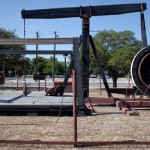Debating the Keystone XL Pipeline
Recently, we wrote about the difficulties in finding a route for the Keystone XL pipeline from the oil sands of Canada through environmentally-sensitive areas of Nebraska to refineries in Texas. While the company behind the pipeline looks for a route that will appease Nebraska’s state government (and await a decision from the Obama administration by the end of February), many StateImpact readers are debating whether the pipeline should exist at all.
Here are some of the more invigorating exchanges from the comments section of our post “Where Not to Put the Keystone XL Pipeline“:
Reader CT was one of the first to ask “How about leaving that oil in the ground and seeking renewable energy sources?” Reader Dale096 agreed, saying “The extraction of this oil uses and pollutes unfathomable amounts of water and destroys vast tracts of Boreal forests. Invest in alternatives, leave fossil fuels in the history books.”
Which prompted ironman2 to ask:
“Like what? Nuclear is the only other scaleable option and Fukashima exposed its flaws. Wind and solar are cups of water when we need a river and they are way to capitally intensive even if they were scaleable. While I agree with your sediment (sic), if it were easy it would be done. We all love to bash the oil / power companies as we subsist off of them.”
Trenalg responded:
“Don’t put it anywhere. Build more means of public transportation, more walking and bike paths, more golf carts, cars using alternate fuels, more wind farms. Replace golf courses with wildlife habitats. Enforce regulations on polluting industries, immediately, holding them to the highest clean standards available, immediately.”
One question that has come up in the comments is why not simply build refineries in Canada to process the crude instead of constructing a pipeline that will bring the fuels to Texas?
Reader StrideOrlov says that it comes down to cost:
“It is far cheaper and safer to move the crude oil to refineries that are located near where the refined products will be used than to refine the crude nearer to the oil wells and then try to transport the very volatile distilled products to distant markets. And remember, refineries are LOT more expensive to build and maintain than pipelines. So you get the added factor that it is cheaper to build a pipeline to move the crude to an existing refinery site than it is to build a whole new refinery.”
Which prompted Bob Ivey to ask:
“The refined products are not used in Texas, they are used all over the country and in most cases shipped by pipeline to terminals where it is transferred to trucks for local delivery. So how would a refinery in Nebraska be different than one in Texas except for access to the Gulf of Mexico for export?”
StrideOrlov responds:
“Actually the refined products ARE used mostly in Texas, supplying the metro areas for San Antonio, Houston, Austin and Dallas/FW, plus the artificial rubber plants in Pasadena (a huge consideration there).
There are major refineries in 2/3 of the states of the U.S. The refineries in the western tip of Texas which supply the surrounding region of N.M., Ariz, southern CO and western Texas. The big ones in the Houston-Beaumont area, plus the ones in sourthern LA supply the south central region as I mentioned above. California has numerous major refineries which supply the West Coast. New Jersey supplies most of that region of the northern East Coast, while Alabama helps cover the SE region. Plus smaller, but still major, refineries all over the central states like MO, MI, IL and so on to fill the gaps.
Transporting gasoline is dangerous and expensive. That is why refineries are spread all over the gasoline-crazed United States. But so much of the artificial rubber that fuel our industry, especially our tire manufacturers, comes from that one town outside of Houston (Pasadena) that the refineries there can never seem to get enough crude to keep up with demand.
While it’s not clear at the moment whether the project will go forward and what route it may take, one thing is readily apparent: The Keystone XL pipeline has become a focal point in the debate over dependence on fossil fuels.



